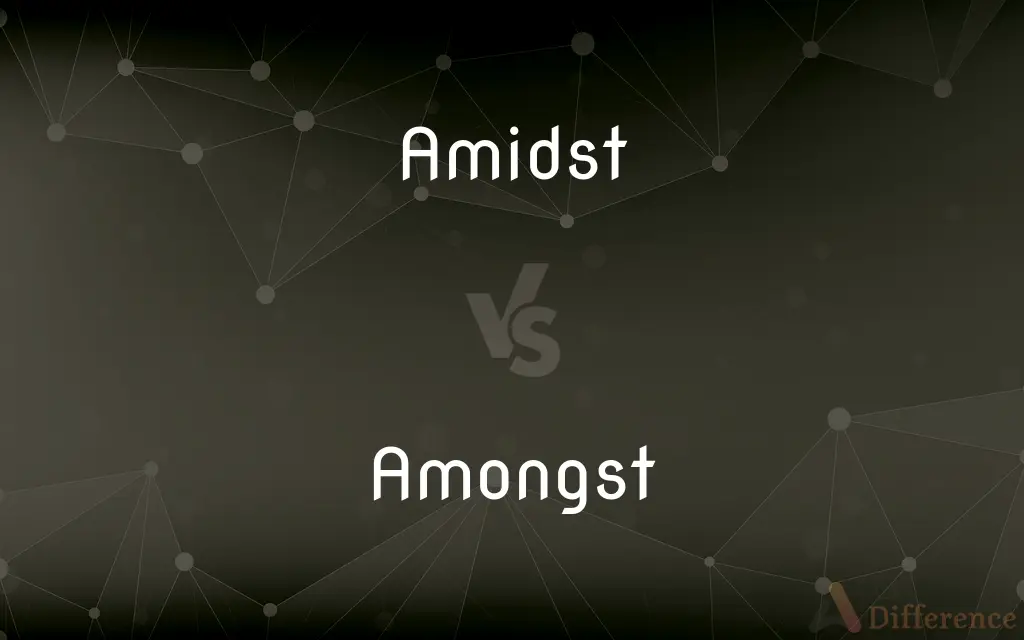Amidst vs. Amongst — What's the Difference?
By Tayyaba Rehman & Maham Liaqat — Updated on April 2, 2024
"Amidst" denotes being surrounded by something, focusing on a singular entity's presence within an encompassing environment, while "Amongst" implies inclusion or involvement in a group or collective.

Difference Between Amidst and Amongst
Table of Contents
ADVERTISEMENT
Key Differences
"Amidst" is used to convey the idea of being in the middle of or surrounded by a particular situation, environment, or context, often emphasizing a singular entity's placement within a broader setting. It suggests a sense of immersion or envelopment. On the other hand, "Amongst" is generally used to denote inclusion within a group or collection of items, suggesting a sense of belonging or being part of a larger number. The distinction lies in "Amidst" highlighting a singular entity's relationship with its surroundings, while "Amongst" focuses on the interactions or relationships within a group.
While both "Amidst" and "Amongst" can be used interchangeably in many contexts, "Amidst" often carries a slightly more poetic or literary tone, suggesting a deeper or more intimate connection with the surrounding environment. For instance, one might say, "She stood amidst the ancient ruins," to evoke a sense of being enveloped by history. Conversely, "Amongst" might be used in a more casual or everyday context, as in, "He found his friends amongst the crowd," indicating his position within the group without the same depth of immersion.
In terms of usage, "Amidst" can also imply a metaphorical or figurative sense of being surrounded by non-physical entities, such as emotions or events. For example, "Amidst the chaos, she found a moment of peace." Whereas "Amongst" is more commonly associated with physical or tangible items or groups, highlighting the notion of being part of a collection, such as "Amongst the options, he chose the least expensive."
Another nuance is that "Amidst" might be used to describe a setting that emphasizes the environment's impact on the entity, suggesting a sense of being overwhelmed or enveloped by it. In contrast, "Amongst" implies a more neutral or even positive sense of association or inclusion within a group without necessarily suggesting the same level of envelopment or impact by the surroundings.
Comparison Chart
Definition
Being in the middle of or surrounded by.
Inclusion or involvement in a group.
ADVERTISEMENT
Usage Context
Often more poetic or literary.
More casual or everyday.
Implied Relationship
Emphasizes relationship with surroundings.
Focuses on interactions within a group.
Metaphorical Use
Can imply a metaphorical envelopment.
Usually denotes physical inclusion.
Nuance of Environment
Suggests impact of environment on entity.
Implies neutral association with group.
Compare with Definitions
Amidst
Often used to convey a poetic or deep immersion.
Amidst the storm, they found shelter.
Amongst
Denotes a sense of belonging to a group.
Amongst the candidates, he was the most qualified.
Amidst
Suggests a singular entity's placement.
Amidst a sea of doubts, one idea stood out.
Amongst
Typically implies physical or tangible inclusion.
Hidden amongst the trees, the cabin awaited.
Amidst
Can imply a metaphorical sense of envelopment.
Amidst her grief, she found hope.
Amongst
In the company of; surrounded by others.
She was amongst friends.
Amidst
Surrounded by; in the midst of.
Amidst the silence, his voice was clear.
Amongst
Focuses on being part of a collection.
Amongst the collection, the rare book was a gem.
Amidst
Used with both physical and metaphorical contexts.
Amidst the ruins, history spoke.
Amongst
Used in more casual contexts.
Amongst the chaos, they remained calm.
Amidst
Variant of amid.
Amongst
In the midst of; surrounded by
A pine tree among cedars.
Amidst
In the midst or middle of; surrounded or encompassed by; among.
Amongst
In the group, number, or class of
She is among the wealthy.
Amidst
In the midst or middle of; surrounded or encompassed by; among.
But rather famish them amid their plenty.
The seraph Abdiel, faithful found;Among the faithless faithful only he,
From amidst them forth he passed,
Those squalid cabins and uncleared woods amidst which he was born.
Amongst
In the company of; in association with
Traveling among a group of tourists.
Amongst
By many or the entire number of; with many
A custom popular among the Greeks.
Amongst
By the joint action of
Among us, we will finish the job.
Amongst
With portions to each of
Distribute this among you.
Amongst
With or against one another
Don't fight among yourselves. See Usage Note at between.
Amongst
Denotes a mingling or intermixing with distinct or separable objects. See usage note at amidst.
Janek feels very at ease amongst his friends, but gets incredibly nervous when meeting new people.
Common Curiosities
Is "Amidst" more formal than "Amongst"?
"Amidst" often carries a more poetic or literary tone, not necessarily more formal.
Can "Amongst" be used for non-physical groups?
While typically for tangible groups, it can extend to non-physical in broad uses.
Does "Amidst" imply a deeper connection than "Amongst"?
It can suggest a deeper or more immersive connection with surroundings.
Are these words used differently in British and American English?
Yes, "Amongst" and "Amidst" are more common in British English, though understood in both.
How does "Amidst" enhance descriptive writing?
"Amidst" can add depth and a sense of immersion, enriching scenes and emotions.
Can "Amidst" only be used with negative contexts?
No, "Amidst" is versatile and can be used in both positive and negative contexts.
Can "Amidst" and "Amongst" be used interchangeably?
Yes, in many contexts they can, though nuances may differ.
What is the origin of "Amidst" and "Amongst"?
Both words trace back to Old English, indicating their longstanding use in the language.
Is "Amongst" suitable for formal writing?
While suitable, "Among" is more commonly used in formal writing, with "Amongst" seen as slightly more archaic.
What are some synonyms for "Amongst"?
Synonyms include "among," "in the company of," and "within a group of."
How does context affect the choice between "Amidst" and "Amongst"?
The desired tone, formality level, and emphasis on relationships or environment guide the choice.
Do "Amidst" and "Amongst" have different prepositional uses?
Their prepositional uses overlap significantly, though nuances in meaning and context may vary.
What are some synonyms for "Amidst"?
Synonyms include "among," "in the midst of," and "surrounded by."
Can "Amidst" be used in abstract concepts?
Yes, it's often used to describe being enveloped by abstract situations, like emotions or events.
How do "Amidst" and "Amongst" contribute to the rhythm of a sentence?
Both can add lyrical or poetic qualities, affecting the sentence's flow and emphasis.
Share Your Discovery

Previous Comparison
Convey vs. Express
Next Comparison
Hill vs. MoundAuthor Spotlight
Written by
Tayyaba RehmanTayyaba Rehman is a distinguished writer, currently serving as a primary contributor to askdifference.com. As a researcher in semantics and etymology, Tayyaba's passion for the complexity of languages and their distinctions has found a perfect home on the platform. Tayyaba delves into the intricacies of language, distinguishing between commonly confused words and phrases, thereby providing clarity for readers worldwide.
Co-written by
Maham Liaqat













































